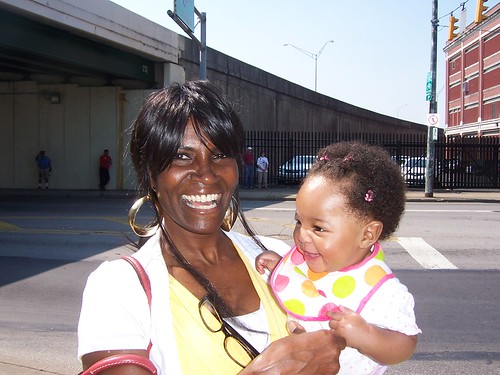How can the mostly white middle class environmental movement engage w/ Black & low-income communities ?
- Artist: Kimberly Jackson Morris
- Title: How can the mostly white middle class environmental movement engage w/ Black & low-income communities ?
- Length: 6:57 minutes (6.36 MB)
- Format: MP3 Stereo 44kHz 128Kbps (CBR)

Kimberly Jackson Morris & Jamira Jamison
tomover@thecolumbusactivist.org
Morris and I spoke during President Obama's visit to Columbus on Sept 13. Most of the protestors who had been there to tell Obama to not approve the Keystone XL Pipeline project had left. Keystone XL would carry tar sands oil from Canada to Texas where it would be refined and shipped to other countries.
There were no people of color in the protest, though a Black elder sat nearby on a lawn chair so as to stay in the shade during the hot September day.
Morris said the under-representation of people of color in the environmental movement is a case in point on the importance of education.
"We're not educated on those facts...When you go into lower economic areas, there's no one standing there giving us information about a pipeline."
Morris said white middle class, environmental activists should spend time in Black and low-income parts of town.
"Go into those communities and talk to people. There are people who aren't too busy to listen. But the information isn't there. Do you go into these communities and speak w/ people about these things that you're protesting ? I'm talking about urban communities."
Morris said standing in the streets holding signs won't necessarily engage people who aren't currently involved with environmental and other causes.
" It's not personable enough. When you address me---me individually, or my community, then I see that you care. I don't want someone standing on a corner yelling some important information that I'm not going to listen to. If I'm on my way to work, or if I'm on my way to pick up a child, no, I'm not going to stop and listen to you. But if you're in my community and I happen to be walking to the community grocer, then yes, you're giving me some information and I'll stop and speak w/ you."
She said activists such as those fighting Keystone XL need to listen to and learn from people in the communities we go into, instead of assuming we're there only to talk and teach what we know.
Morris suggested the Eastside near downtown as a specific place for engaging w/ Black and low-income communities.
"When you get close to Columbus State and Fort Hayes, really lower economic areas, people don't mind listening. If they know you're there for a reason, they'll stop and talk w/you---if you're there."
Morris agreed urban farming and community gardening are ways to form bridges between the mostly white and middle class environmental movement and people living in historically under-served communities.
"My daughters and I are building a garden. We believe in organic food...I don't like chemical pesticides and fertilizers. But if you go into the poor areas, this is all we're eating. Everything is loaded w/ chemicals. Everything is processed. We don't have the information though to know any better. Until we get the information to know any better, how can we do any better ? "
She said churches are an important venue for forming new ties among activists and community organizers.
"Churches are number 1 in Black communities. You get on board w/ the ministers and pastors and they'll help you. You have to inform them as well. But they will get the word out to their church members."
- Login to post comments
